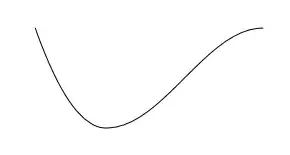Today during lesson, my mechanics teacher provided a diagram of a "bowl" of the following shape:

The top left and the top right have the same height, and the top right part is horizontal.
He claimed that if you release a point particle from the top of the track on the left, it will take an infinite amount of time for it to reach the top right. His reason was that if the time is finite, and when you reverse it, the particle will start from equilibrium but spontaneously performs motion, which is impossible.
This reason seems too vague for me to understand the claim, so I tried to prove (or disprove) it mathematically, but I failed to do so. Can anyone explain this to me?
The following are my attempts to tackle the problem.
Since he did not specify the details of its shape, as an example I constructed a bowl which is a parabola $x^2$ on the left until the bottom, then a $1-\cos(x)$ on the right.
My first attempt was to ignore the left part and to consider it to have an initial speed of $\sqrt{2gh}$ at the bottom of the bowl. Denoting the horizontal displacement as $x$, I expressed $\theta$, the angle that the tangent at $x$ makes with the horizontal, as a function of $x$. ($\tan\theta=\frac{dy}{dx}=\sin x$.) Resolving forces shows that the force down the slope was $mg\sin\theta$, so the acceleration at any point must be $g\sin(\arctan(\sin x))$, which isn't very helpful when I try to integrate...
After reading Point particle moving on a frictionless semicircular hill, I also tried to express the energy at any point as a function of the angle, but I failed to find an expression for speed as a function of the angle.
(In fact in the very beginning I modelled the shape of the bowl as a part of the function $-e^{-x}\cos x$, but I gave up.)